ROMANIA’S CENTER GOVERNMENT FALLS, FASCISTS IN?
Bucharest, Romania · December 21, 1937
On this date in 1937 Romania’s last free elections (until 1990) ended in the ouster of the middle-of-the road National Liberal government. The Liberals, who remained the largest party in parliament, were unable to form a coalition government with the next two runner-up parties. A week later King Carol II named the leader of the far-right National Christian Party, the anti-Semitic politician, poet, and playwright Octavian Goga, to head a new government, despite the fact that Goga’s party came in fourth, with 9.3 percent of the popular vote. Prime Minister Goga immediately embarked on a program to establish a personal dictatorship. Goga’s regime instituted a paramilitary wing of fascist character, the Lancieri (Lance-bearers). The Lancieri borrowed heavily from a popular ultra-nationalist, anti-communist, anti-Semitic competing group, the Iron Guard, also known as the Legionnaire movement (1930–1941), which Goga attempted to outflank and which was also involved in violence against Romania’s 800,000 Jews who lived mostly in the north of the country, where they formed the third largest community of Jews in Europe. During his brief period in power, Goga gained renown for passing Romania’s first anti-Semitic laws. Beginning on January 12, 1938, his government stripped Romanian Jews of their short-held citizenship, granted them in 1919–1923; barred Jews from the civil service and the army; and forbade them to buy property and practice certain professions. Goga was quoted in The New York Times in January 1938 as saying: “The Jewish problem is an old one here, and it is a Rumanian tragedy. Briefly, we have far too many Jews.” Goga proposed collecting all Jews and relocating them to an “uninhabited” region, the further away the better. Many of his countrymen felt the same way, for in that same year, 1938, anti-Jewish riots swept across Romania. When Goga suffered a stroke and died in early May 1938, his body lay in state in Bucharest’s Palace Athenaeum. Those mourning his passing included Germany’s head of state, Adolf Hitler, who sent a floral tribute to adorn Goga’s glass-top casket. Within 2‑1/2 years Romania was firmly in Hitler’s orbit. Of all his allies, Romania was responsible for the deaths of more Jews than any country other than Germany itself.
[amazon_carousel widget_type=”ASINList” width=”600″ height=”200″ title=”Recommended Reading” market_place=”US” shuffle_products=”False” show_border=”False” asin=”0803220642,0976582112,1566637716,0841909105,0300151276,0742557154,0966573471,006016106X,0814338720,1566633265″ /]
Romania’s Iron Guard Revolt and Jewish Pogrom, January 21–23, 1941
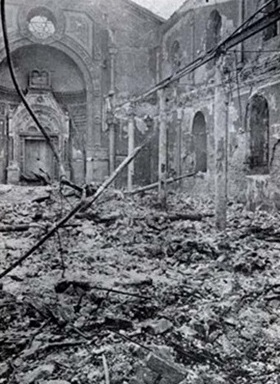 | 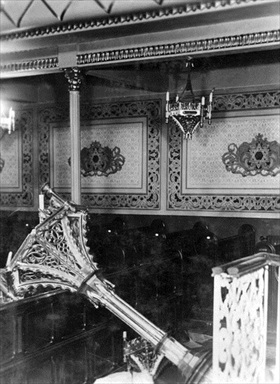 |
Left: Sephardic Temple in Bucharest after it was robbed and set on fire during a revolt of the paramilitary Iron Guard between January 21 and 23, 1941. Prime Minister Gen. Ion Antonescu had invited the Iron Guard, as a powerful political, long-persecuted movement, to join his cabinet the previous September even as he worked to curb their influence. It was an uneasy alliance for that reason and because many Iron Guard followers were vengeful toward anyone associated with the regime. On January 21, 1941, the Iron Guard launched a rebellion (Legionary Rebellion) to overthrow Antonescu and seize control of the country. After three days of brutal street fighting, the Romanian army was able to crush the putschists, but only after their rebellion had erupted into a vicious pogrom against Jews. Antonescu banned the Iron Cross movement and imprisoned 9,000 of its members.
![]()
Right: Interior of a ruined synagogue, Bucharest, Romania, January 23, 1941. Legionnaires, as members of the Iron Guard were called, consisted of anti-Semitic students, priests, intellectuals, young and old, men, women, and children. Legionary gangs swooped down on Bucharest’s Jewish districts to grab whatever they could carry away before vandalizing and setting fire to twenty-five synagogues, demolishing Jewish-owned stores, and plundering the homes of Jews. Signs posted on Jewish homes read “Kikes live here!” Homes of Christians displayed religious symbols, icons, or signs reading “Christians live here.”
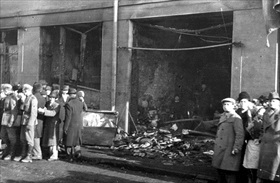 | 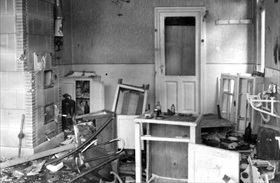 |
Left: Jewish stores destroyed, Bucharest, Romania, January 23, 1941. For three and a half days, the capital’s Jewish districts were at the mercy of mobs encouraged by state media controlled by the Legionnaires. Even soldiers were attacked. During this time, several thousand Jews were dragged out of their homes and arrested on the streets or in synagogues where they had sought refuge. Among them were lay leaders of the Jewish community, rabbis, personnel from synagogues and Jewish community offices, as well as Jewish journalists, writers, doctors, and engineers. They were taken to previously established destinations such as the Legionary Headquarters, police precincts, and even to designated synagogues, where they were subjected to torture or murder or both. Many were driven to the Jilava forest and shot.
![]()
Right: A Jewish doctor’s office wrecked in the Bucharest pogrom, January 23, 1941.
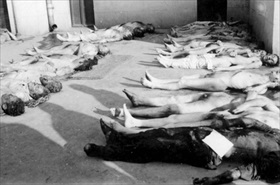 | 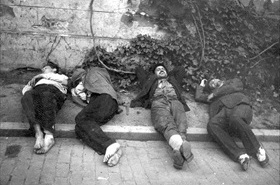 |
Left: Bodies of Jewish people are laid out at the Jewish Legal Institute, Bucharest, Romania. After the pogrom, by January 27, 1941, workers of the Jewish community offices had identified 121 of the dead; however, 400 were still missing. In many instances, Legionnaires had mutilated the victims and stripped them of their clothes.
![]()
Right: People wounded in the pogrom lie in a Bucharest street, January 23, 1941. At dawn that day a truck from the Podsudeck sausage factory was loaded with fifteen Jews who had been held under police arrest. They were driven to the municipal slaughterhouse at Baneasa and murdered with 100 other Jews who were captive there. Some had the word “kosher” marked on their corpses. While this carnage took place inside the slaughterhouse, a large number of Legionnaires were outside singing and mocking Jewish psalms and prayers. Another group of Jews was taken to a farm in Bucharest’s Straulesti district, where they were shot.
Scenes of Bucharest, Romania’s Capital, Between the World Wars
![]()

 History buffs, there is good news! The Daily Chronicles of World War II is now available as an ebook for $4.99 on Amazon.com. Containing a year’s worth of dated entries from this website, the ebook brings the story of this tumultuous era to life in a compelling, authoritative, and succinct manner. Featuring inventive navigation aids, the ebook enables readers to instantly move forward or backward by month and date to different dated entries. Simple and elegant! Click
History buffs, there is good news! The Daily Chronicles of World War II is now available as an ebook for $4.99 on Amazon.com. Containing a year’s worth of dated entries from this website, the ebook brings the story of this tumultuous era to life in a compelling, authoritative, and succinct manner. Featuring inventive navigation aids, the ebook enables readers to instantly move forward or backward by month and date to different dated entries. Simple and elegant! Click 











